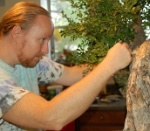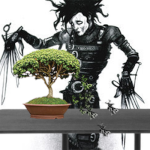Buxus Sempervirens (Big)
+2
Russell Coker
Anderson Almeida
6 posters
Page 1 of 1
 Re: Buxus Sempervirens (Big)
Re: Buxus Sempervirens (Big)
Wow, that's a nice find. Naturally, it looks like a live oak to me... so that's what I'd do with it.
(In case you missed it... https://ibonsaiclub.forumotion.com/t10757-live-oaks-and-boxwoods )
Are you sure this is sempervirens? It's too hot and humid - or we don't have enough winter - for me to grow sempervirens here on the Gulf Coast. I'm inclined to think this is microphylla, Japanese boxwood.
What a beauty!
R

Russell Coker- Member
 Re: Buxus Sempervirens (Big)
Re: Buxus Sempervirens (Big)
Extremely nice material. Nice find.
I agree with Russell, though. It doesn't look like sempervirens to me. The leaves on sempervirens are lance-shaped. The leaves on this one, from what I can tell in the photos, are more rounded and a little on the large side for English boxwood. I'd bet on microphylla too.
I agree with Russell, though. It doesn't look like sempervirens to me. The leaves on sempervirens are lance-shaped. The leaves on this one, from what I can tell in the photos, are more rounded and a little on the large side for English boxwood. I'd bet on microphylla too.
rockm- Member
 Re: Buxus Sempervirens (Big)
Re: Buxus Sempervirens (Big)
Wow, nice material. There is little or nothing you need to do to the nebari, its more or less done as is the first level of ramification. I would not cut any of the major branches, keep it the style it is. All you need to do is reduce the height and develop foliage pads. I would not try to make it a single trunk. Keep it the informal broom style or live oak tree style that it currently is. Nice.

Leo Schordje- Member
 Re: Buxus Sempervirens (Big)
Re: Buxus Sempervirens (Big)
Leo's right. If it were mine I'd be picturing a tree with a broad, spreading crown. I'd look at the way the trunk splits into the different lines, as well as the nebari, to choose the best front. As you follow those lines up you'll see where to cut back to create taper and movement, and reduce the overall heigth. After that you should end up with plenty of new options for making secondary and tertiary branch structure.
How far can you cut it back? Last year we had an interesting discussion about how far back you can safely prune a boxwood. Joey McCoy and I had different results in different climates, possibly based on humidity levels. I can't remember where it is, possibly in one of Dario's (poink88) boxwood threads. You may have to do some searching. Anyway, to be on the safe side you may want to leave green on the end of your branches, at least until you get a good flush of new growth.
Does anyone (in America) have a decent looking collected sempervirens in their collection? Just curious.
R
How far can you cut it back? Last year we had an interesting discussion about how far back you can safely prune a boxwood. Joey McCoy and I had different results in different climates, possibly based on humidity levels. I can't remember where it is, possibly in one of Dario's (poink88) boxwood threads. You may have to do some searching. Anyway, to be on the safe side you may want to leave green on the end of your branches, at least until you get a good flush of new growth.
Does anyone (in America) have a decent looking collected sempervirens in their collection? Just curious.
R

Russell Coker- Member
 Re: Buxus Sempervirens (Big)
Re: Buxus Sempervirens (Big)
I've not seen a sempervirens bonsai here in Virginia, but there are some spectacular specimens in old plantations. Here's a photo I ran across online -- it's a DWARF sempervirens at George Mason's place (Gunston Hall) out on Mason Neck in N. Va. It and the others in the allee behind the house were planted as small shurbs over 200 years ago. Wish they'd let some bonsaiists dig it up for more suitable landscape material 
http://www.flickr.com/photos/brownpau/7185682464/
http://www.flickr.com/photos/brownpau/7185682464/
rockm- Member
 Re: Buxus Sempervirens (Big)
Re: Buxus Sempervirens (Big)
Sweet Jesus! I remember seeing sempervirens like that at Waverly Plantation (1852) not far from Mississippi State when I was getting my landscape architecture degree there after Japan. That's only about 4 hours north of me here on the Coast, but they just slowly die here over a period of years. And the spider mites say they are delicious....

Russell Coker- Member
 Re: Buxus Sempervirens (Big)
Re: Buxus Sempervirens (Big)
Nice trees Anderson! Especially that top Buxus - it has a terrific natural quality and movement aleady. These all have wonderful single trunks with great root bases and branching. All of them need to be cut back, and as Russell pointed out.. it's always safe to leave some green leaves on the ends of each branch. In my area (dry, low humidity), it seems that there are typically less existing buds sleeping on bare branches, which means if there isn't a leaf/branch there now, there may not ever be one in the future (without grafting). I personally don't think you need to worry too much about styling at this point, but to cut them back roughly and try to give each branch taper & movement. A large, spreading broadleaf tree seems to be the natural form that these will take. As Russell said, an old Oak image would be a good thing to keep in mind. You may have another tree locally to draw inspiration from. Just please do NOT try to force any of these to look like a tiered Asian "bonsai" design! That would ruin all the wonderful wild quality that is so beautiful here.
I also agree that it looks like B. microphylla to me instead of B. sempervirens. I'm not sure there is a rule about sempervirens.. aren't they native to the S. of France, Italy and the Mediterranian? All very hot climates. A friend of mine has a few dozen small plants grown from cuttings planted out in the ground, and they've done well here for the past 6 years or so. Not exactly a scientific test, but they're the only oness I've seen locally to observe. B. microphylla is just the common species planted here in my area (along with a few B. harlandii).
Rockm - those boxwoods need to be kept a secret, lest they go missing some day! Actually, I wonder if those are a dwarf form.. the leaves don't look too out-of-place small, and the trunks look like they've had some MAJOR chops in the past to get them back into a small size like this. They may have been a huge wall-hedge of boxwood that had some dieback and were subsequently chainsawed back to "rejuvinate" them.
I also agree that it looks like B. microphylla to me instead of B. sempervirens. I'm not sure there is a rule about sempervirens.. aren't they native to the S. of France, Italy and the Mediterranian? All very hot climates. A friend of mine has a few dozen small plants grown from cuttings planted out in the ground, and they've done well here for the past 6 years or so. Not exactly a scientific test, but they're the only oness I've seen locally to observe. B. microphylla is just the common species planted here in my area (along with a few B. harlandii).
Rockm - those boxwoods need to be kept a secret, lest they go missing some day! Actually, I wonder if those are a dwarf form.. the leaves don't look too out-of-place small, and the trunks look like they've had some MAJOR chops in the past to get them back into a small size like this. They may have been a huge wall-hedge of boxwood that had some dieback and were subsequently chainsawed back to "rejuvinate" them.

JMcCoy- Member
 Re: Buxus Sempervirens (Big)
Re: Buxus Sempervirens (Big)
I've have success in hard pruning B. Koreana (a cultivar of B. Microphylla) back to sections with no leaves. But leaving some green on a branch can help. In other words, on Anderson's boxwood, I'd cut the branching back to two or three leaves. Those will support the branches until resting buds pop.
The boxwood at Gunston are indeed dwarf types, the original records of their purchase are still on file with Fairfax County and historical societies, if I remember correctly. Dwarfing doesn't refer to leaf size, it refers to the tighter denser foilage and closer, slower growing habits. They have been hacked back over the last 250 years, but disease has also taken its toll on them. They are pretty safe, as the site is heavily protected as a national monument, just like Mt. Vernon five miles upriver.
The boxwood at Gunston are indeed dwarf types, the original records of their purchase are still on file with Fairfax County and historical societies, if I remember correctly. Dwarfing doesn't refer to leaf size, it refers to the tighter denser foilage and closer, slower growing habits. They have been hacked back over the last 250 years, but disease has also taken its toll on them. They are pretty safe, as the site is heavily protected as a national monument, just like Mt. Vernon five miles upriver.
rockm- Member
 Re: Buxus Sempervirens (Big)
Re: Buxus Sempervirens (Big)
The boxwood at Gunston are indeed dwarf types, the original records of their purchase are still on file with Fairfax County and historical societies, if I remember correctly. Dwarfing doesn't refer to leaf size, it refers to the tighter denser foilage and closer, slower growing habits. They have been hacked back over the last 250 years, but disease has also taken its toll on them. They are pretty safe, as the site is heavily protected as a national monument, just like Mt. Vernon five miles upriver.
If these are developed dwarf varieties from 200 years ago (something I've never heard about in a boxwood), someone in the parks service or the Nat'l arboretum should take cuttings and sell a line of "Gunston Dwarfs"!

JMcCoy- Member
 Re: Buxus Sempervirens (Big)
Re: Buxus Sempervirens (Big)
Have no idea if the "dwarf" thing is accurate horticulturally, but that's what the records say apparently. Gunston Hall is a National Historic Landmark owned by the Commonwealth of Virginia. As such--well--government works in slow, sometimes silly ways, so I don't think they're going to sell any cuttings from those boxwoods  . There was talk about 10 years ago of ripping the old boxwood out to return the garden to its "original" state--small, clipped boxwood lining the path...
. There was talk about 10 years ago of ripping the old boxwood out to return the garden to its "original" state--small, clipped boxwood lining the path...  I think that plan was abandoned.
I think that plan was abandoned.
rockm- Member
 Re: Buxus Sempervirens (Big)
Re: Buxus Sempervirens (Big)
Just saw this boxwood and it is awesome! I had to resurrect this thread. 
I'd probably add a layer of brick on this and bury the nebari a bit deeper. I'd also trim the top a lot ...maybe by half?
Would love to see how it is now if possible. Thank you.
I'd probably add a layer of brick on this and bury the nebari a bit deeper. I'd also trim the top a lot ...maybe by half?
Would love to see how it is now if possible. Thank you.

Poink88- Member
 Similar topics
Similar topics» Buxus sempervirens
» Buxus sempervirens
» buxus sempervirens
» Transplanting buxus sempervirens
» Sequoia Sempervirens
» Buxus sempervirens
» buxus sempervirens
» Transplanting buxus sempervirens
» Sequoia Sempervirens
Page 1 of 1
Permissions in this forum:
You cannot reply to topics in this forum













